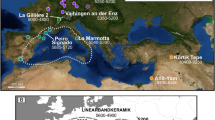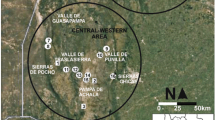Abstract
In this paper we report on the first 14C dated archaeological seeds from the island of Newfoundland, Canada. Ninety-three archaeobotanical specimens were recovered from a midden deposit adjacent to a small dwelling at Point Riche (EeBi-20), a large Dorset Palaeoeskimo site near Port au Choix, northwestern Newfoundland. These remains were collected from a seemingly secure context within the midden, but AMS 14C testing of a sample of specimens produced modern 14C dates, indicating that the remains are intrusive to the Dorset occupation. While the majority of Newfoundland-based research assumes antiquity of archaeobotanical remains, we recommend using AMS 14C dating and other proxy data in future archaeobotanical studies to confirm antiquity prior to making interpretations regarding human–plant interactions.


Similar content being viewed by others
References
Anstey RJ (2011) The Dorset Palaeoeskimo sites of Point Riche and Phillip’s Garden, Port au Choix, northwestern Newfoundland: investigating social and functional connections. Master’s thesis, Department of Archaeology, Memorial University, St. John’s
Anstey RJ, Renouf MAP, Wells PJ, Lavers D (2010) A report of the 2010 archaeological field season at the Port au Choix National Historic Site: excavations at Point Riche. Parks Canada, Western Newfoundland and Labrador Region, Rocky Harbour
Beattie AJ, Culver DC (1982) Inhumation: how ants and other invertebrates help seeds. Nature 297:627
Beaudoin AB, Wright M, Ronaghan B (1996) Late Quaternary landscape history and archaeology in the ‘Ice-Free Corridor’: some recent results from Alberta. Quat Int 32:113–126
Benz BF, Cheng L, Leavitt SW, Eastoe C (2006) El Riego and early maize agricultural evolution. In: Staller JE, Tykot RH, Benz BF (eds) Histories of maize: multidisciplinary approaches to the prehistory, linguistics, biogeography, domestication, and evolution of maize. Academic Press, Amsterdam, pp 73–82
Boyd M, Running GL, Havholm K (2003) Paleoecology and geochronology of glacial Lake Hind during the Pleistocene-Holocene transition: a context for Folsom surface finds on the Canadian prairies. Geoarchaeology 18:583–607
Bronk Ramsey C (2008) Radiocarbon dating: revolutions in understanding. Archaeometry 50:249–275
Bronk Ramsey C, Lee S (2013) Recent and planned developments of the program OxCal. Radiocarbon 55:720–730
Burzynski M, Marceau A, Nichols W, Hermanutz L (2006) Discovering the limestone barrens of western Newfoundland. Memorial University Botanical Garden, St. John’s
Crawford GW, Smith DG, Bowyer VE (1997) Dating the entry of corn (Zea mays) into the lower Great Lakes region. Am Antiq 62:112–119
Damman AWH (1983) An ecological subdivision of the island of Newfoundland. In: South GR (ed) Biogeography and ecology of the island of Newfoundland. Junk, Boston, pp 163–206
Dawson JE (1977) Identification of samples of archaeological seeds from L’Anse aux Meadows, Newfoundland. Prepared for Parks Canada, Western Newfoundland and Labrador Region, Rocky Harbour
Deal M (2005) Palaeoethnobotanical research at Port au Choix. Nfld Labrador Stud 20:131–156
Deal M (2008) Paleoethnobotanical research in the Maritime Provinces. N Atl Archaeol 1:1–23
Deal M, Butt A (2002) The great want: current research in Beothuk palaeoethnobotany. In: Mason SLR, Hather JG (eds) Hunter-gatherer archaeobotany: perspectives from the northern temperate zone. Institute of Archaeology, University College London, London, pp 15–27
Dodson JR, Li X, Zhou X, Zhao K, Sun N, Atahan P (2013) Origin and spread of wheat in China. Quat Sci Rev 72:108–111
Eastaugh EJH (2002) The Dorset Palaeoeskimo site at Point Riche: an intra-site analysis. Master’s thesis, Department of Archaeology, Memorial University of Newfoundland, St. John’s
Eastaugh EJH (2003) A Middle Dorset semi-subterranean dwelling at Point Riche, Newfoundland. Études/Inuit/Studies 27:451–471
Eastaugh EJH, Taylor J (2005) Geophysical survey of the Dorset Palaeoeskimo site of Point Riche. Nfld Labrador Stud 20:157–173
Erwin JC (2001) A prehistoric soapstone quarry in Fleur de Lys, Newfoundland. Doctoral dissertation, University of Calgary, Calgary
Fritz GJ (1997) A 3,000-year-old cache of crop seeds from Marble Bluff, Arkansas. In: Gremillion KJ (ed) People, plants, and landscapes: studies in paleoethnobotany. University of Alabama Press, Tuscaloosa, pp 42–62
Gajewski K, Munoz S, Peros M, Viau A, Morlan R, Betts M (2011) The Canadian archaeological radiocarbon database (CARD): archaeological 14C dates in North America and their paleoenvironmental context. Radiocarbon 53:371–394
Gilbert W (1992) ‘Great good done’: Beothuk/European relations in Trinity Bay, 1612 to 1622. Nfld Q 87:2–10
Guiry EJ, Deal M, Kiraly E (2010) Paleoeskimo paleoethnobotany: research from the Port au Port site (DdBq-1), Newfoundland. N Atl Archaeol 2:43–66
Hartery L (2006) A microscopic approach to Paleoeskimo plant use. In: Rankin L (ed) From the Arctic to Avalon: papers in honour of Jim Tuck. (BAR Internat Ser 1507). Archaeopress, Oxford, pp 71–79
Hedges REM, Housley RA, Law IA, Perry C, Hendy E (1988) Radiocarbon evidence from the Oxford AMS system (Archaeometry datelist 8). Archaeometry 30:291–305
Hedges REM, Housley RA, Bronk CR, Van Klinken GJ (1991) Radiocarbon dates from the Oxford AMS system (Archaeometry datelist 13). Archaeometry 33:279–296
Higham TFG, Bronk Ramsey C, Brock F, Baker D, Ditchfield P (2010) Radiocarbon dates from the Oxford AMS system (Archaeometry datelist 34). Archaeometry 53:1,067–1,084
Holly DH (2013) History in the making: the archaeology of the eastern Subarctic. Altamira Press, Lanham
Howse L, Drouin B (2000) Paleoethnobotanical analysis of the Dorset component at Parke’s Beach. Student paper, on file, Department of Archaeology, Memorial University, St. John’s
Hua Q, Barbetti M, Rakowski AZ (2013) Atmospheric radiocarbon for the period 1950–2010. Radiocarbon 55:2,059–2,072
Jamieson JB (1990) The archaeology of the St. Lawrence Iroquoians. In: Ellis CJ, Ferris N (eds) The archaeology of southern Ontario to A.D. 1650. Ontario Archaeological Society, London, pp 385–404
Keepax C (1977) Contamination of archaeological deposits by seeds of modern origin with particular reference to the use of flotation machines. J Archaeol Sci 4:221–229
Lacourse T, Delepine JM, Hoffman EH, Mathewes RW (2012) A 14,000 year vegetation history of a hypermaritime island on the outer Pacific coast of Canada based on fossil pollen, spores and conifer stomata. Quat Res 78:572–582
Ledger PM, Edwards KJ, Schofield JE (2013) Shieling activity in the Norse Eastern Settlement: palaeoenvironment of the ‘Mountain Farm’, Vatnahverfi, Greenland. Holocene 23:810–822
Lepofsky D, Moss ML, Lyons N (2001) The unrealized potential of paleoethnobotany in the archaeology of northwestern North America: perspectives from Cape Addington, Alaska. Arct Anthropol 38:48–59
Long A, Benz B, Donahue D, Jull A, Toolin L (1989) First direct AMS dates on early maize from Tehuacán, Mexico. Radiocarbon 31:1,035–1,040
Lyons N, Orchard TJ (2007) Sourcing archaeobotanical remains: taphonomic insights from a midden analysis on Haida Gwaii, British Columbia. Can J Archaeol 31:28–54
Martin AC, Barkley WD (1961) Seed identification manual. University of California Press, Berkeley
Matthews JV, Schweger CE, Hughes OL (1990) Plant and insect fossils from the Mayo Indian Village section (central Yukon): new data on Middle Wisconsinan environments and glaciation. Géogr Phys Quat 44:15–26
McWeeney L (1989) What lies lurking below the soil: beyond the archaeobotanical view of flotation samples. N Am Archaeol 10:227–230
Meades SJ, Hay SG, Brouillet L (2000) Annotated checklist of vascular plants of Newfoundland and Labrador. Department of Forest Resources and Agro Foods, Parks Canada and Western Newfoundland Model Forest Inc., Sault Ste. Marie
Miksicek CH (1987) Formation processes of the archaeobotanical record. Adv Archaeol Method Theory 10:211–247
Minnis PE (1981) Seeds in archaeological sites: sources and some interpretive problems. Am Antiq 46:143–152
Mithen S, Finlay N, Carruthers W, Carter S, Ashmore P (2001) Plant use in the Mesolithic: evidence from Staosnaig, Isle of Colonsay, Scotland. J Archaeol Sci 28:223–234
Moerman DE (2010) Native American food plants: an ethnobotanical dictionary. Timber Press, Portland
Montgomery FH (1977) Seeds and fruits of plants of eastern Canada and northeastern United States. University of Toronto Press, Toronto
Morales J, Pérez-Jordà G, Peña-Chocarro L, Zapata L, Ruíz-Alonso M, López-Sáez JA, Linstädter J (2013) The origins of agriculture in North-West Africa: macrobotanical remains from Epipalaeolithic and Early Neolithic levels of Ifri Oudadane (Morocco). J Archaeol Sci 40:2,659–2,669
Nydal R (1989) A critical review of radiocarbon dating of a Norse settlement at L’Anse aux Meadows, Newfoundland, Canada. Radiocarbon 31:976–985
Pastore RT (1992) Shanawdithit’s people. Atlantic Archaeology, St. John’s
Pearsall DM (2001) Paleoethnobotany: a handbook of procedures. Emerald Group Publishing, Cornwall
Pelling R, Campbell G, Carruthers W, Hunter K, Marshall P (2015) Exploring contamination (intrusion and residuality) in the archaeobotanical record: case studies from central and southern England. Veget Hist Archaeobot 24:85–99
Piperno DR, Flannery KV (2001) The earliest archaeological maize (Zea mays L.) from highland Mexico: new accelerator mass spectrometry dates and their implications. Proc Natl Acad Sci 102:1,147–1,151
Prebble M, Wilmshurst JM (2009) Detecting the initial impact of humans and introduced species on island environments in Remote Oceania using palaeoecology. Biol Invasions 11:1,529–1,556
Renouf MAP (1985) Archaeology of the Port au Choix National Historic Park: Report of 1984 activities. On file, Parks Canada, Archaeology, Atlantic Division, Halifax
Renouf MAP (2002) Archaeology at Port au Choix, northwestern Newfoundland 1990–1992 (Occasional Papers in Northeastern Archaeology 12). Copetown Press, St. John’s
Renouf MAP (2011a) The life history of Port au Choix landscapes. In: Renouf MAP (ed) The cultural landscapes of Port au Choix. Springer, New York, pp 271–300
Renouf MAP (2011b) Radiocarbon dates from Port au Choix. In: Renouf MAP (ed) The cultural landscapes of Port au Choix. Springer, New York, pp 301–316
Rouleau E (1978) List of the vascular plants of the province of Newfoundland (Canada). Oxen Pond Botanic Park, St. John’s
Shen-Miller J, Mudgett MB, Schopf JW, Clarke S, Berger R (1995) Exceptional seed longevity and robust growth: ancient sacred lotus from China. Am J Bot 82:1,367–1,380
Smart TL, Hoffman ES (1988) Environmental interpretation of archaeological charcoal. In: Hastorf CA, Popper VS (eds) Current palaeoethnobotany. University of Chicago Press, Chicago, pp 167–205
Smith BD, Cowan CW (1987) Domesticated Chenopodium in prehistoric eastern North America: new accelerator dates from eastern Kentucky. Am Antiq 52:355–357
Staller J (2009) Maize cobs and cultures: history of Zea mays L. Springer, New York
Stuiver M, Polach HA (1977) Discussion of reporting of 14C data. Radiocarbon 19:355–363
Temple B (2007) The 1966-69 archaeological excavations at Back Harbour, North Twillingate Island, Newfoundland. On file, Provincial Archaeology Office, Government of Newfoundland and Labrador, St. John’s
Tuck JA (1976) Ancient people of Port au Choix. Institute of Social and Economic Research, St. John’s
UCI KCCAMS Facility (2010) Sample submission. Department of Earth System Science, University of California. Electronic document: http://www.ess.uci.edu/group/ams/sample-submission
UCI KCCAMS Facility (2011a) Acid/base/acid (ABA) sample pre-treatment. Department of Earth System Science, University of California. Electronic document: http://www.ess.uci.edu/group/ams/files/aba_protocol.pdf
UCI KCCAMS Facility (2011b) Graphitization protocol, hydrogen reduction method (organic samples). Department of Earth System Science, University of California. Electronic document: http://www.ess.uci.edu/group/ams/files/organic_graphitization_protocol.pdf
Wagner GE (1982) Testing flotation recovery rates. Am Antiq 47:127–132
Wallace BL (2006) Westward vikings: the saga of L’Anse aux Meadows. Historic Sites Association of Newfoundland and Labrador, St. John’s
Wilmshurst JM, Higham TFG (2004) Using rat-gnawed seeds to independently date the arrival of Pacific rats and humans in New Zealand. Holocene 14:801–806
Acknowledgments
This research was conducted during Anstey’s Masters research at Memorial University, St. John’s, which was funded by the Social Sciences and Humanities Research Council of Canada, Memorial University, the Canada Research Chairs Program, Parks Canada, the Institute for Social and Economic Research and the Provincial Archaeology Office. Vaughan Grimes, Memorial University, paid for the AMS dates and reviewed a draft of this paper. In addition to Anstey and Renouf, the 2010 excavation crew at Point Riche included Tom Farrell, Mariane Hardenberg, Dominique Lavers, Susan Penney, Tessa Plint and site supervisor Patricia Wells. We would like to thank John Southon and Hector Martinez at the Keck AMS Lab for their assistance and insight in preparing and running our samples and also Joe Hepburn at the University of British Columbia for his help with processing seeds for AMS dating. Finally, we would like to thank the Associate Editor and two anonymous reviewers for their helpful comments.
Author information
Authors and Affiliations
Corresponding author
Additional information
Communicated by K. Brown.
Rights and permissions
About this article
Cite this article
Anstey, R.J., Guiry, E.J., Renouf, M.A.P. et al. Dating archaeobotanical remains: a cautionary tale from Port au Choix, Newfoundland. Veget Hist Archaeobot 25, 75–84 (2016). https://doi.org/10.1007/s00334-015-0526-y
Received:
Accepted:
Published:
Issue Date:
DOI: https://doi.org/10.1007/s00334-015-0526-y




